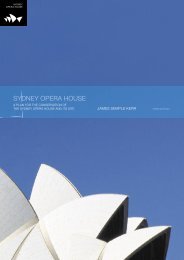nomination by the Government of Australia - Sydney Opera House
nomination by the Government of Australia - Sydney Opera House
nomination by the Government of Australia - Sydney Opera House
You also want an ePaper? Increase the reach of your titles
YUMPU automatically turns print PDFs into web optimized ePapers that Google loves.
60<br />
Part 4. State <strong>of</strong> conservation and factors affecting <strong>the</strong> property<br />
There are demands for <strong>the</strong> <strong>Sydney</strong> <strong>Opera</strong> <strong>House</strong> to<br />
maintain its position as a state <strong>of</strong> <strong>the</strong> art performing<br />
arts centre. Occasional adaptation to <strong>the</strong> property is<br />
necessary to allow <strong>the</strong> <strong>Sydney</strong> <strong>Opera</strong> <strong>House</strong> to meet<br />
<strong>the</strong> technological and clientele requirements <strong>of</strong> a<br />
national and world-class performing arts centre. At <strong>the</strong><br />
same time, <strong>the</strong> aspiration for functional excellence can<br />
complement and reinforce <strong>the</strong> performance arts aspect<br />
<strong>of</strong> its heritage signifi cance. The Conservation Plan<br />
(SOH) emphasises <strong>the</strong> need to balance <strong>the</strong> different<br />
roles <strong>of</strong> <strong>the</strong> <strong>Sydney</strong> <strong>Opera</strong> <strong>House</strong> as a monument<br />
and a successful performance venue. Legislation and<br />
associated conservation mechanisms enable <strong>the</strong>se<br />
twin objectives to be achieved in ways that preserve<br />
<strong>the</strong> property’s heritage values. All changes to <strong>the</strong><br />
building and <strong>the</strong> site are undertaken within a rigorous<br />
conservation planning framework.<br />
The recent building works to <strong>the</strong> <strong>Sydney</strong> <strong>Opera</strong><br />
<strong>House</strong> have been undertaken in accordance with<br />
<strong>the</strong> Conservation Plan (SOH) and <strong>the</strong> <strong>Sydney</strong><br />
<strong>Opera</strong> <strong>House</strong> Utzon design principles 2002 (Utzon<br />
Design Principles). This has ensured that <strong>the</strong> current<br />
improvements retain <strong>the</strong> au<strong>the</strong>nticity <strong>of</strong> <strong>the</strong> building as<br />
a performing arts centre. Substantial work has been<br />
undertaken <strong>by</strong> <strong>the</strong> <strong>Sydney</strong> <strong>Opera</strong> <strong>House</strong> Trust and<br />
relevant New South Wales <strong>Government</strong> agencies to<br />
defi ne an appropriate framework for both <strong>the</strong> day-today<br />
and <strong>the</strong> long-term conservation <strong>of</strong> <strong>the</strong> <strong>Sydney</strong><br />
<strong>Opera</strong> <strong>House</strong>.<br />
4.B (ii) Environmental pressures<br />
The <strong>Sydney</strong> <strong>Opera</strong> <strong>House</strong> is exposed to several<br />
environmental pressures but <strong>the</strong> means for managing<br />
<strong>the</strong>ir effects are in place.<br />
<strong>Sydney</strong> is located on <strong>the</strong> south-eastern seaboard <strong>of</strong><br />
<strong>the</strong> <strong>Australia</strong>n continent facing <strong>the</strong> Pacifi c Ocean and is<br />
subject to ‘El Niño’ climatic effects. Over recent years,<br />
<strong>Sydney</strong> has experienced reduced rainfall patterns<br />
but this has not had a measurable effect on <strong>the</strong><br />
building. In its exposed position, <strong>the</strong> <strong>Sydney</strong> <strong>Opera</strong><br />
<strong>House</strong> can also experience strong winds, with <strong>the</strong><br />
strongest recorded being under 180 kilometres per<br />
hour. The building was designed to withstand wind<br />
loads <strong>of</strong> this level and higher. Pioneering wind-tunnel<br />
technology was used to test wind pressures during<br />
<strong>the</strong> construction <strong>of</strong> <strong>the</strong> building.<br />
The <strong>Sydney</strong> <strong>Opera</strong> <strong>House</strong> is subject to a combination<br />
<strong>of</strong> environmental infl uences due to its exposed harbourside<br />
location. These include salt water, wave action,<br />
high winds, atmospheric pollutants and solar radiation<br />
particularly in relation to <strong>the</strong> large ro<strong>of</strong> and glass wall<br />
areas. The in situ and reinforced concrete structure <strong>of</strong><br />
<strong>the</strong> <strong>Sydney</strong> <strong>Opera</strong> <strong>House</strong>, with its tile-clad shells and<br />
precast reconstituted granite-clad podium, is vulnerable<br />
to <strong>the</strong> problems <strong>of</strong> concrete decay typical for a building<br />
in a maritime environment. Exposed concrete poses<br />
specifi c technical challenges because <strong>the</strong> surface fi nish<br />
and <strong>the</strong> structure are integrated. Also, concrete repair<br />
is physically invasive and can have a signifi cant visual<br />
impact if not managed carefully. Sophisticated testing<br />
and repair programs are in place to ensure that <strong>the</strong><br />
concrete elements remain in excellent condition. These<br />
programs are discussed in Part 6.A.<br />
Conservation challenges arising from environmental<br />
pressures have been comprehensively identifi ed and<br />
managed at <strong>the</strong> <strong>Sydney</strong> <strong>Opera</strong> <strong>House</strong>. The original<br />
materials chosen were <strong>of</strong> a very high quality (such<br />
as <strong>the</strong> glazed tiles, concrete and bronze used in <strong>the</strong><br />
handrails) and sophisticated construction techniques<br />
were used. A proactive and rigorous building<br />
maintenance program is in place to deal with <strong>the</strong><br />
critical areas <strong>of</strong> material risk. Each critical item (such<br />
as <strong>the</strong> concrete, reconstituted pink granite, tiles and<br />
<strong>the</strong> bronze) has a conservation program identifi ed

















